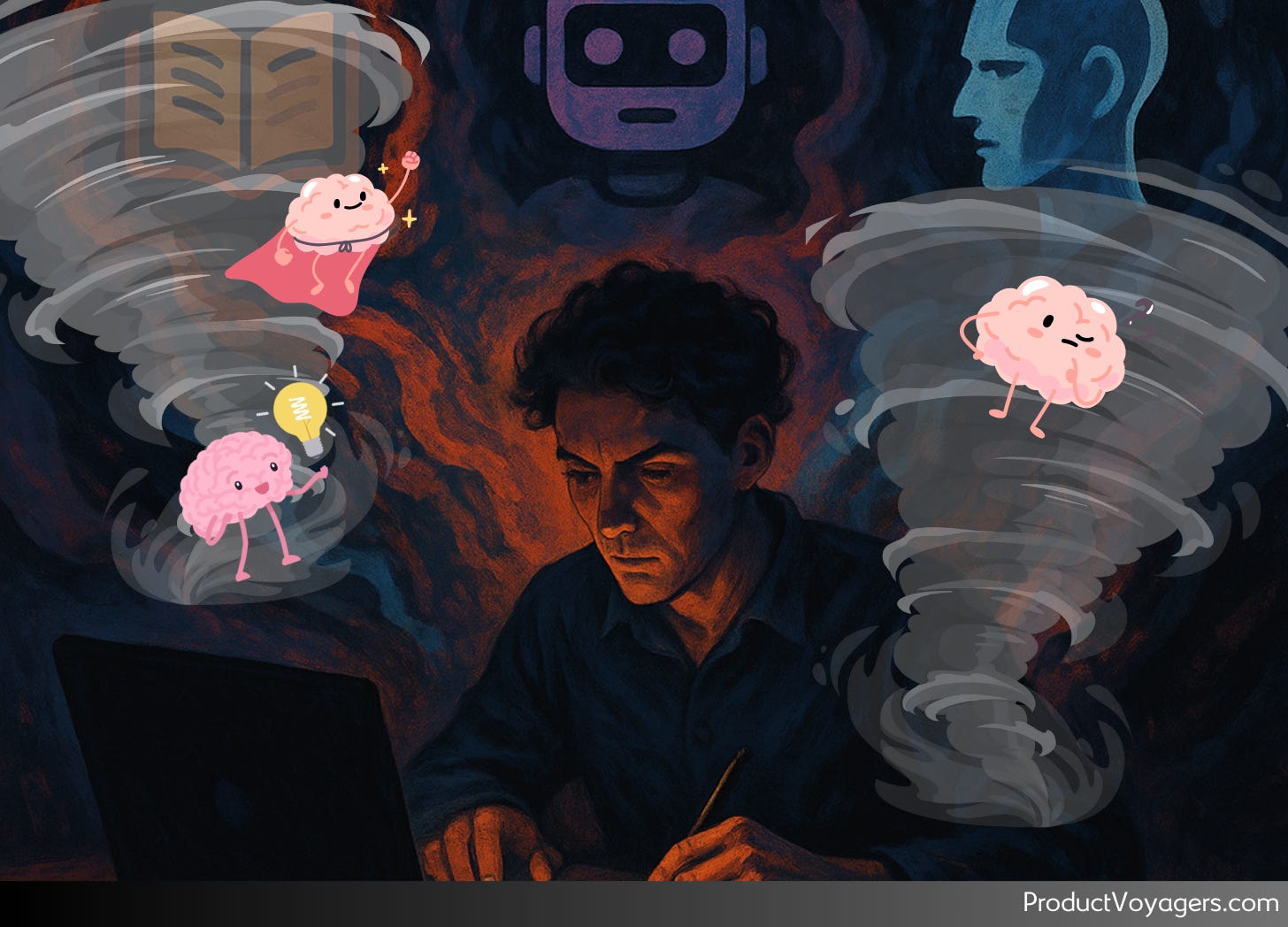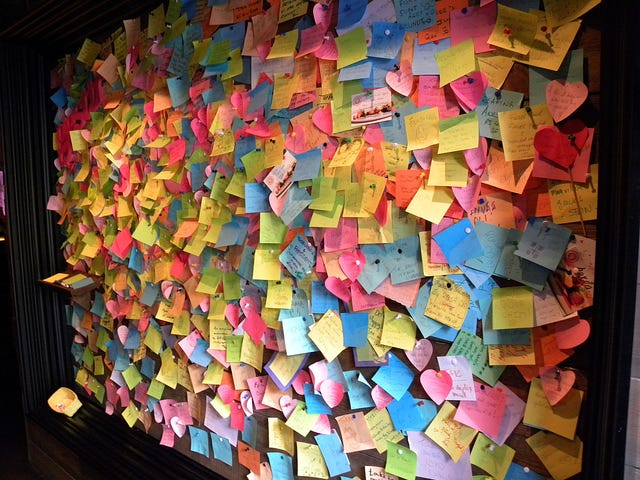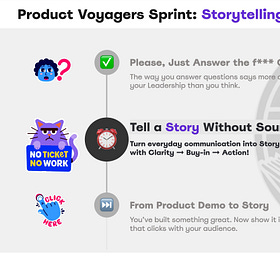AI as Your Product-Storytelling Co-Pilot 🤌
NotebookLM · ChatGPT · Claude.ai → A "Story Stack" To Sell Your Narrative, Not Just The Feature
Welcome to Part 4 of "Product Voyagers' Sprint: Storytelling in Product". A 7-part, hands-on course that turns everyday communication into powerful mini-narratives.
Let’s start from here:
AI won't write your product story for you.
But it will absolutely demolish the tedious grunt work that keeps you from finding the story buried in your research pile.
Note: If you’ve ever second-guessed how your story lands, rewritten the same thing ten times, or watched your message fall flat in a meeting, then this piece is for you.
I've spent the last six months experimenting with AI as a storytelling partner (not replacement), and what I've discovered will change how you approach narrative building forever.
And by the way, this isn’t about chasing or creating viral posts. It’s about using the right tools to uncover what matters, refine your message, and build stories that actually move people and products forward.
Unbundling: Story vs. Storytelling
Before we dive into tools, let's get something straight:
A story is the recipe / Storytelling is how you plate and serve a meal.
What does that mean?
Story = It’s the content itself.
A structured sequence of events (real or imagined) with characters, a setting, conflict (real stakes), and resolution (happy/bad end).
Storytelling = It’s the delivery.
Everything else. The tone, timing, medium, metaphors, and emotional texture that makes people feel the story.
Remember: AI touches the storytelling layer.
Then, what about the story layer?
That's still 100% you, and anyone who tells you otherwise is selling something.
Neurological Hijack: Something You Need to Know
And what most people don't understand about human psychology: that our brains literally can't process plain information (ex.: project status, roadmaps, product vision) the same way they process stories.
When you present something in analytical format (ex.: features and timelines), you're speaking to the analytical mind that judges, questions, and finds reasons to say no.
Flip? When you tell a story (a real story with tension and transformation) you bypass all that rational resistance and speak directly to the part of the brain that drives belief and action.
This isn't manipulation, don't get me wrong, but it's recognition of how humans actually make decisions. We don't choose products based on feature matrices.
So, Why I Actually Use an AI Co-Pilot
Because of three reasons, backed by six months of real usage:
#01. Recall on Demand
I had over 40 pages of chaos: strategy docs/updates, product specs, onsite user interview transcripts, roadmap updates, competitive slides plus a mess of post-its from a recent internal bootcamp.
Somewhere in that pile was the insight I needed to shape the story, but finding it felt like hunting for a needle in a narrative haystack.
Before AI, this would’ve meant two days of skimming, highlighting, second-guessing, and slowly running out of steam.
Now I just dropped everything into AI Co-pilot, asked one sharp question, and within a minute it surfaced the real tension: our users were begging for simplicity while our stakeholders were pushing for complexity.
#02. Relentless Iteration
You tweak it. Still not right. You try again. And again.
You know that feeling when you're almost there. The hook is close, the framing feels right, but something's off.
Normally, you'd run out of time or patience. But AI doesn’t blink. It doesn’t get bored or burnt out. It lets you push through version twelve, fifteen, twenty until the right words finally lock into place.
That’s not automation. That’s creative endurance, on demand.
#03. Instant Perspective Shifts
One story. Five audiences. Five reactions.
What makes sense to an engineer might fall flat with a CPO. Or, what excites a designer could confuse a commercial lead.
This was always one of the hardest parts of product storytelling. You shape the message carefully, but the moment it enters a new room, it starts to break.
Reframing it felt like guessing. You tweak one part, soften another, and end up with something that pleases no one.
So I changed how I approach it.
Before sharing anything, I walk through the eyes of each audience using a Co-pilot. The engineer who looks for logic. The executive who watches cost. The user who needs it to feel simple. And each one shows me where things don’t land.
Your Three-Tool Story Stack
After testing dozens of AI tools, three have earned permanent spots in to solve such workflow:
Librarian: NotebookLM
Best for: Finding the narrative thread in messy, scattered information and it works seamlessly with Google Enterprise accounts, which most teams already use.
Last month, I fed NotebookLM all my research from that internal bootcamp (exactly: 87 Sticky Notes as pictures), 40+ pages of conflicting opinions, onsite user feedbacks, and strategic directions & updates. Instead of spending days trying to synthesize it myself, I asked one question:
"What's the biggest tension or contradiction across all these documents?"
The answer came back in 47 seconds with exact citations:
our users were screaming for simplicity while our stakeholders were demanding more features. That contradiction became the backbone of my entire product narrative.
My workflow:
Upload everything such as (specs, transcripts, competitive analyses, meeting notes)
Ask: "What tension unifies these documents?"
Get insights with traceable citations
Follow up: "What evidence supports the opposite view?"
🪄 Storytelling Tip: Want to dive deeper into NotebookLM’s capabilities? Check out this excellent post by Wyndo [A Real AI Maker]👇
Improv Partner: ChatGPT
Best for: Rapid iteration on hooks and framings to deliver your message.
I use ChatGPT like a creative writing partner who never gets tired.
When I'm stuck on how to frame a complex technical concept, I'll paste the core idea and ask for 10 different analogies. Then I'll pick the one that makes me lean forward and ask for variations.
My workflow:
Paste the core concept or value prop
Ask: "Give me 10 ways to explain this to [specific audience]"
Pick the best one
Iterate: "Same concept, but make it 30% more urgent"
🪄 Storytelling Tip: Use ChatGPT O3 for better thinking and resolution, but you really need to have your product skills when you communicate the prompt: Clear, Effective and explain your expected outcomes. Use the CORE model when you communicate as if you're messaging a colleague or peer in your team. Full article is here 👇
Tell a Story Without Sounding Like a Jerk 🤌
Welcome to Part 2 of “Product Voyagers’ Sprint: Storytelling in Product”.
Perspective Checker: Claude.ai
Best for: Stress-testing narratives through different stakeholder lenses to find gaps.
This is where I catch blind spots before they become meeting disasters.
I'll feed Claude my draft narrative and ask it to react as different personas, skeptical engineer, budget-conscious CFO, impatient user.
My workflow:
Upload draft narrative
Ask: "React to this as [specific persona with specific concerns]"
Note where trust or clarity breaks down
Revise and repeat with different personas
Your 5-Step AI-Assisted Story Workflow
So now you have a structured way to build product narratives and the toolset to do it faster, better, and sharper.
1. Anchor (NotebookLM) Feed all research into NotebookLM. Extract one sentence that captures the central tension. Everything else hangs off this.
2. Explore (ChatGPT) Jam on hooks and analogies until one feels inevitable. The right metaphor makes complex products instantly graspable.
3. Refine (Claude) Role-play critical stakeholders. Patch every clarity gap before you present.
4. Package (Your Choice) Choose the medium that best shows value, video demos for flow, interactive docs for complexity, slides for simplicity.
5. Iterate (All Tools) Each product change deserves a fresh narrative pass. AI makes this feasible in days, not weeks.
Fundamentals That Never Change 🙏
Please before you leave and despite all these shiny tools, 3 fundamentals remain:
01/ Clarity beats cleverness. A muddy message stays muddy in 8K video with Dolby surround sound.
02/ Truth beats polish. AI hallucinations destroy trust faster than brilliant storytelling builds it. This is why source-grounded tools like NotebookLM matter.
03/ Relevance trumps everything. Formats will keep changing, but humans still ask the same question: “Why should I care about this right now?”
And in the end, AI won’t replace product storytellers any more than calculators replaced mathematicians.
However the ones who use it with intent, like a precision tool, will absolutely outperform those who don’t.
So - Use it well for your Advantage.
Unlock Storytelling In Product Full Course
Want more like this? Subscribe to unlock the full “Storytelling in Product” course.
7 parts, hands-on, and made for product people like you.






Love this! Step 3 of your process is genius. "Your" genius... =]